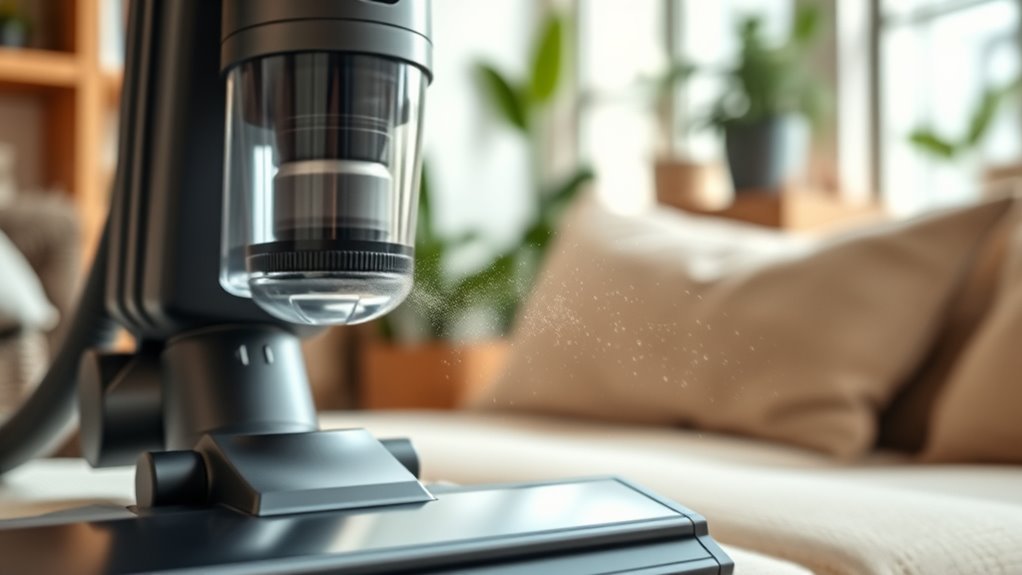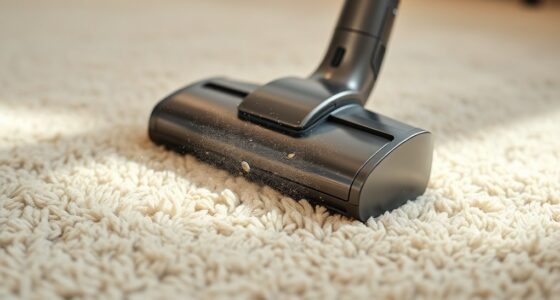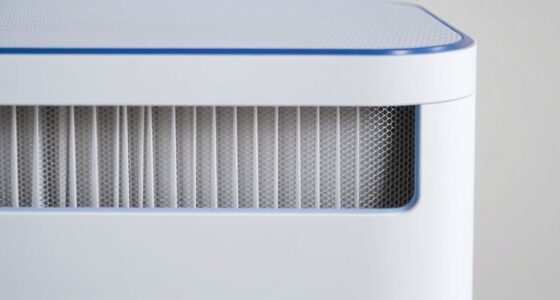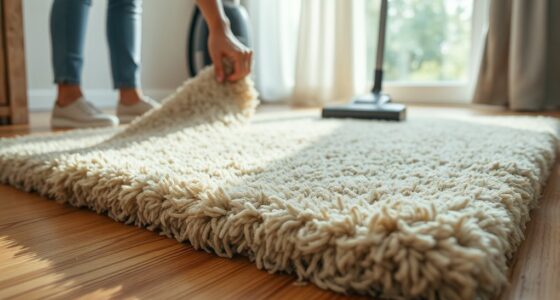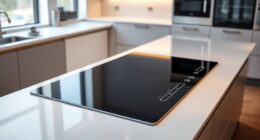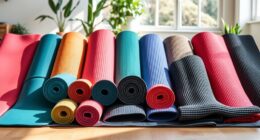To help manage chronic sinus issues, vacuum regularly using a vacuum with a HEPA filter, which traps tiny airborne allergens like dust, pet dander, and pollen. Focus on areas like carpets, upholstery, and curtains, and keep your vacuum maintained to prevent allergens from re-entering the air. Combining vacuuming with nasal irrigation can further clear nasal passages and reduce flare-ups. Keep exploring for more evidence-based tips to improve your sinus health.
Key Takeaways
- Use a vacuum with a HEPA filter to effectively trap airborne allergens that worsen sinus issues.
- Regularly clean and maintain vacuum filters and attachments to prevent allergen re-release.
- Focus vacuuming on high-traffic areas like carpets, upholstery, and curtains where allergens accumulate.
- Combine vacuuming with nasal irrigation to enhance sinus clearance and reduce congestion.
- Consistent vacuuming reduces overall allergen load, decreasing the frequency and severity of sinus flare-ups.
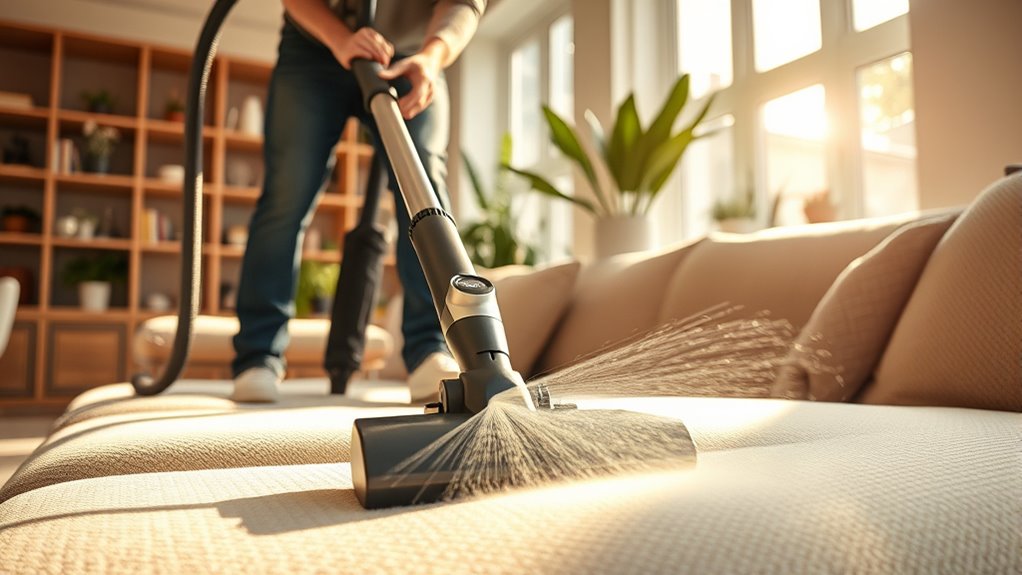
If you suffer from sinus issues, vacuuming might seem unrelated, but it can actually help reduce allergens and irritants that trigger your symptoms. Regular vacuuming removes dust, pet dander, pollen, and other airborne particles that can irritate your nasal passages. Using a vacuum with a HEPA filter maximizes these air purifier benefits, trapping tiny particles that traditional vacuums might recirculate into your environment. This reduces the overall allergen load in your home, making it easier to breathe and decreasing the frequency and severity of sinus flare-ups.
Vacuuming with a HEPA filter reduces allergens and eases sinus flare-ups.
Incorporating targeted nasal irrigation techniques into your routine can also profoundly improve your sinus health. Nasal irrigation involves flushing your nasal passages with saline solution, clearing out mucus, allergens, and irritants that accumulate overnight or throughout the day. When combined with a clean environment created by regular vacuuming, nasal irrigation becomes even more effective. It helps maintain clear nasal passages and can reduce the need for medication in some cases. You might find that performing nasal irrigation after vacuuming ensures a fresher, less congested feeling.
It’s important to prioritize the cleanliness of your vacuum tools as part of your allergy management. Regularly changing filters, emptying the dustbin, and cleaning the vacuum’s attachments prevent the buildup of mold and bacteria, which can worsen sinus issues. A well-maintained vacuum system, especially one equipped with HEPA filters, enhances the air purifier benefits by preventing the re-emission of allergens into your indoor air. Additionally, understanding the signs of spoilage in lemon juice can help you ensure your household supplies remain safe and effective for your health routines.
Beyond cleaning, you should also consider the placement of your vacuuming efforts. Focus on areas where dust and pet dander tend to accumulate most, such as carpets, upholstery, and curtains. These surfaces trap allergens that can become airborne when disturbed. Consistent vacuuming, coupled with the use of air purifiers, creates a cleaner environment that minimizes sinus irritants.
While vacuuming and nasal irrigation techniques are helpful, they’re most effective when part of a holistic approach to managing sinus health. Reducing indoor humidity, avoiding smoking, and maintaining good overall hygiene all contribute to lessening your sinus problems. Remember, creating a cleaner environment through regular vacuuming with a HEPA filter and supporting it with nasal irrigation can profoundly improve your comfort and breathing. These evidence-based tips make a practical difference in managing chronic sinus issues effectively.
Frequently Asked Questions
Can Vacuuming Help With Allergies Unrelated to Sinus Issues?
You might wonder if vacuuming helps with allergies unrelated to sinus issues. It can, because vacuuming removes airborne allergens and dust from your home, reducing what you breathe in daily. Using a HEPA filter vacuum captures tiny particles better, helping to improve air quality. Regular vacuuming keeps dust and allergens at bay, making your environment healthier and potentially easing allergy symptoms, even if they’re not specifically linked to sinus problems.
What Safety Precautions Should I Take When Vacuuming My Face?
Think of your face skin as a delicate garden needing gentle care. When vacuuming with a vacuum device, always start with clean, dry skin and use the lowest suction setting. Keep the device at least an inch away from your face, avoiding sensitive areas like eyes and mouth. Never press too hard, and limit vacuuming sessions to prevent irritation. These precautions help protect your skin while you explore this unconventional method.
How Often Is It Safe to Vacuum for Sinus Relief?
You might wonder about safe vacuum frequency for sinus relief. Generally, it’s best to follow safety guidelines and not overdo it—vacuuming once or twice a week is usually safe. Avoid daily vacuuming to prevent irritation or injury. Listen to your body, and if you experience discomfort, reduce the frequency. Always consult a healthcare professional for personalized advice, especially if you have underlying sinus issues or sensitivities.
Are There Specific Vacuum Devices Recommended for Sinus Problems?
Specifically, select a vacuum device with gentle, adjustable features suited for sinus sensitivity. Look for models offering customizable suction levels, ensuring you don’t overwhelm your nasal passages. Devices with soft, flexible tips and easy-to-clean designs are recommended to reduce irritation and maximize comfort. You should prioritize options that provide safe, controlled cleaning, helping you clear congestion without causing damage—making your sinus care simple, safe, and satisfying.
Can Vacuuming Replace Traditional Sinus Treatments or Medications?
Vacuuming can’t replace traditional sinus treatments or medications, but it can be part of alternative therapies to help manage symptoms. You should continue your medical treatments as prescribed by your doctor, since vacuuming alone isn’t enough. Incorporate gentle nasal cleaning techniques, like using a saline spray or rinse, to support your health. Always consult your healthcare provider before trying new methods, ensuring safe and effective sinus care.
Conclusion
As you vacuum your home, it’s almost like a coincidence that you’re also helping your sinuses breathe easier. The simple act of cleaning can reduce dust and allergens, giving your nasal passages relief. So, next time you’re tidying up, remember that your routine might be working in your favor more than you realize. It’s a small, everyday coincidence that could make a big difference in your sinus health—without any extra effort.
